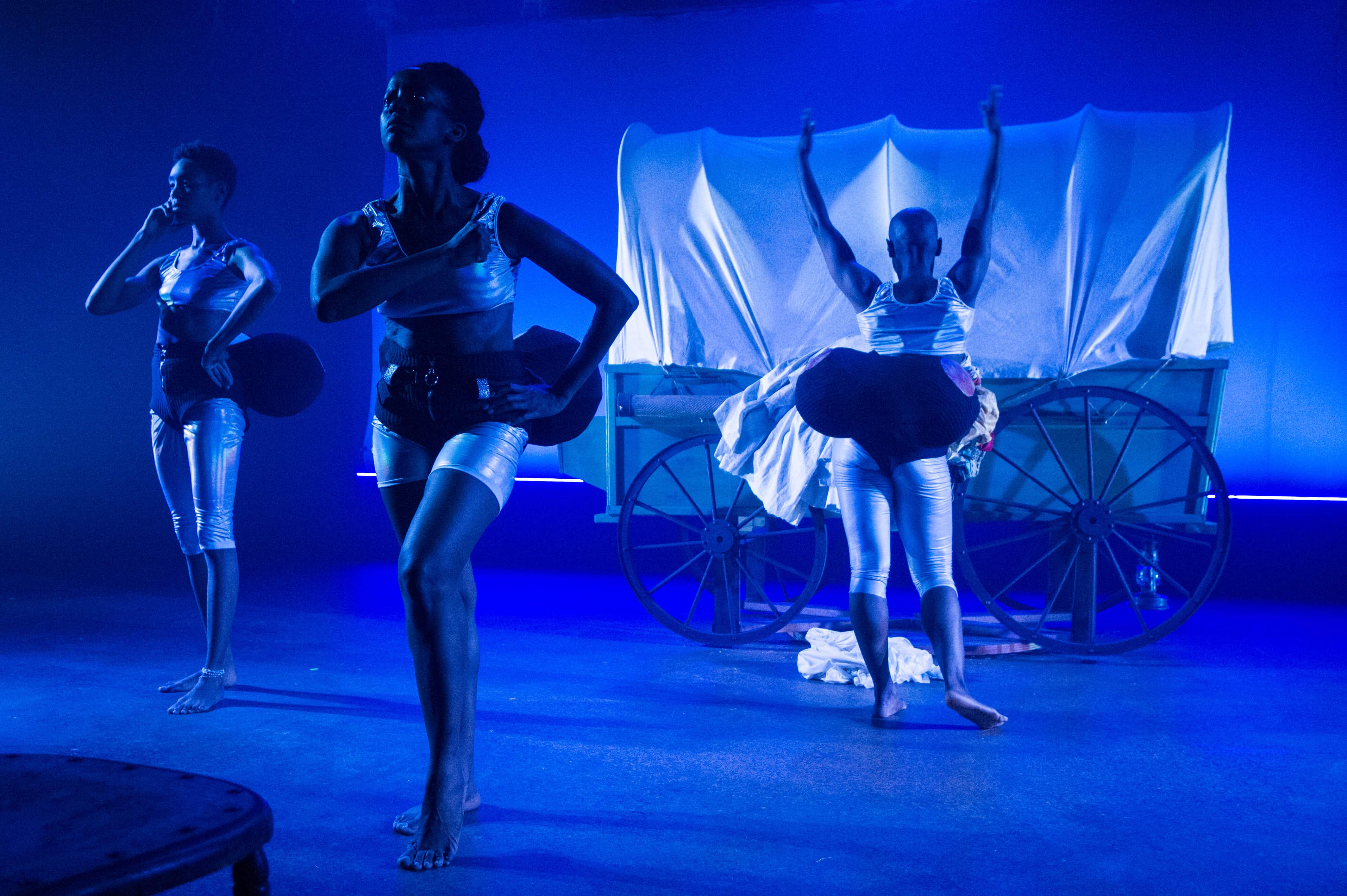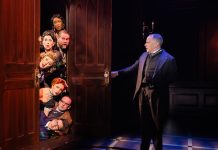The prodigiously imaginative performance artist Holly Bass belongs to the first generation of her family not to pick cotton for a living. I learned that startling fact as I passed through an art installation on the way to a workshop performance of her latest devised dance-theater work, The Trans-Atlantic Time Traveling Company. Suspended from the ceiling were panels of silk imprinted with photographs of cotton fields and an image of Bass in a 19th-century white dress. As a banjo played, I was led toward the stage set and further back in time. Commanding the playing area was a rustic covered wagon surrounded by wooden crates and tin cookware, all under spreading moss-hung branches. Even the accommodations were transporting: one could sit in any of several dozen old-fashioned wooden rockers and chairs.
Read Lisa Traiger’s interview with Holly Bass, “Holly Bass Celebrates Black Sisterhood in ‘The Trans-Atlantic Time Traveling Company’”
A special event workshop staging copresented by Theater Alliance and Anacostia Playhouse, The Trans-Atlantic Time Traveling Company features a cast of three—Bass (as Margaret) plus her collaborators Kailasa Aqueel (as Ruth) and Jasmine Hearn (as Jemma). As Sound Designer Evan Cook has birds chirp and as the sky shines blue behind Scenic Designer Tim Jones’s picturesque set, the three performers—all former slaves—enter barefoot in ruffled white house dresses and go about chores, cooking and hanging out laundry. “We’re safe, we’re freed now,” they say.

The three freedwomen spin the covered wagon around to display the sign on its side: “The Trans-Atlantic Time Traveling Company.” They are en route with their distinctive road show, and they have stopped off right here in the present. What follows is an amiable conceptual variety show—a melange of songs, sketches, and dance—that gently entices the audience into an inquiry about what it means to be free if society is not just.
Costume Designer Jeannette Christensen gives each of the three freedwomen an exaggerated bustle under which are mounted two big inflated balls mounted upon the buttocks. “We offer the finest potions and the most marvelous entertainment,” they tell us, as they begin pitching us a magic elixir oil. One of the three, Ruth, enters as a man blind from birth. He is offered the allegedly curative elixir but it doesn’t work and he leaves disappointed. Suddenly he rushes back exulting that he can see. Already the audience is part of the show, so when the performers pass out edible infusions of the healing elixir (waxed-paper-wrapped candy), everyone takes one.
There is some dark energy afoot. A frightening darkness that overwhelms them, in Lighting Designer Max Doolittle’s bold execution. And the audience is asked directly to share their fears of the dark, whether from childhood or now. A few do. But the performers are reassuring: There is beauty and comfort in the dark, the audience is urged to see. “Darkness isn’t something to be afraid of.”
Some broad vaudeville comedy comes into play. There’s a laugh-out-loud sketch in which Margaret’s knee begins to enlarge alarmingly. It gets enormous. But the sisterhood of traveling transplants have a cure for that (wait for it…): Knee-Grow No More. It comes in quart-size bottles and “it will eliminate your Knee-Grow Problem.”
Throughout are lovely original tunes by Composer Sam Crawford blended with fun musical quotations, such as from the Talking Heads and “Billy don’t lose my number.” A story is told of Ruth’s fluency in the art of mouth percussion from Timbuktu; suddenly she’s delivering a rousing round of beatboxing.

At one point the performers take off their period dresses and do a very modern dance in phosphorescent lycra tights and tops, their appended balls providing rebound when bouncing on their behinds. At another point they do a hoedown square-dance, inviting audience members to join in. At yet another point they sing the spiritual “In That Great Getting Up Morning.”
The easy commingling of then and now together with a freeform blend of genres enlivened by a delightfully personable cast make this short-run workshop iteration of The Trans-Atlantic Time Traveling Company a most enjoyable and uplifting experience.
And in the end, each audience member leaves with authentication in the form of a certificate that they personally are indeed free.
Running Time: 80 minutes, with no intermission.
The Trans-Atlantic Time Traveling Company played July 26 to 29, 2018, at Theater Alliance in collaboration with Anacostia Playhouse performing at the Anacostia Playhouse – 2020 Shannon Place, SE, in Washington DC.




